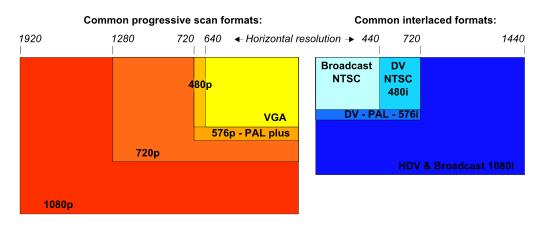DV, HDV, Wafian Quality Comparison  Comparing the technology used in DV and High Definition Video is an almost unfair comparison of apples to oranges. After all, HDV offers resolutions up to 4.5 times larger than DV with HDVís most common resolutions being 1920x1080 and 1280x720 (16:9 aspect ratio), versus DVís 720x480 (4:3 aspect ratio). Comparing the technology used in DV and High Definition Video is an almost unfair comparison of apples to oranges. After all, HDV offers resolutions up to 4.5 times larger than DV with HDVís most common resolutions being 1920x1080 and 1280x720 (16:9 aspect ratio), versus DVís 720x480 (4:3 aspect ratio).

The DV codec uses strictly an intraframe (spatial) scheme, whereas HDV uses the well-established MPEG 2 video codec. MPEG-2 applies both intraframe (spatial) and interframe (temporal) to video-compression. This allows HDV to achieve its higher spatial resolution at the target bitrate of 19 Mbit/sec and 25 Mbit/sec. MPEG-2 video enables HDV to achieve a much higher compression ratio than DV, but at the cost of motion-induced artifacts in scenes of complex motion. The artifacts are a limitation of the compression technology and bitrate allocated to the video bitstream. Nevertheless, HDV is truly stunning on HD displays and cinemas. DV tends to look fuzzy when scaled up to HD resolutions, therefore most viewers accept HDV's visual artifacts in exchange for a significantly more detailed picture. 
| DV at 720x480 (16:9 ratio for comparison purposes) | 
| HDV at 1920x1080 (standard 16:9 ratio) |
About the only major similarity between DV and HDV is the fact that they share the same physical storage medium, 60 minute MiniDV cassettes (tape). This point then brings us onto our more interesting next comparison. HDV vs. Wafian's 4:2:2 Likely you are already working with HD equipment and are looking not only for a more efficient way to manage your media, but to do so while getting the highest possible quality out of your HD camera. Wafian recorders are the answer to both. As noted above, some of HDVís limitations are related to the introduction of block artifacts (noise) through DCT compression when recording to tape. Wafian's recorders use the Cineform Intermediate format instead, which uses a full-frame temporal Wavelet transform to avoid loss of quality in your images. to avoid loss of quality in your images. The HR-1 and HR-2 record using 4:2:2 chroma sub-sampling, versus HDVís 4:2:0. As illustrated below, this means a substantial difference in the color detail of your images. The 4:4:4 HR-2 is of course, that much more superior. Compare yourself by downloading the actual frames as exported from Final Cut Pro. WARNING: These files are large and downloading them will require a fast Internet connection. 1920x1080 HDV Flowers 1920X1080 HR1 Flowers This article is licensed under the GNU Free Documentation License. It uses material from the Wikipedia article HDV and Chroma sub sampling. |